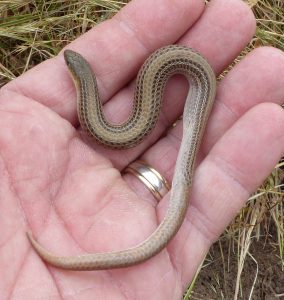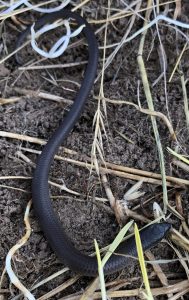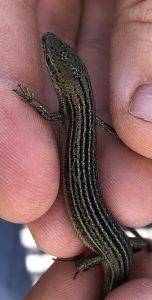Striped Legless Lizard update from Long Point
Tile grid surveys were set up at Long Point Restoration Reserve in the southern Grampians at Dunkeld back in 2012 – long before NGT became the custodian of this patch – as part of the Dunkeld Pastoral Company’s (DPC) interest in surveying the fauna of the property through a Biodiversity Fund project. In the course of their monitoring, DPC set up roofing tile grids to find Striped Legless Lizard (Delma impar) at Long Point, a nationally listed threatened reptile species found in southern Australia, predominantly within grassland and grassy woodland sites. Long Point is a combination of both these vegetation communities with an overstorey of River Red Gum and an improved pasture on the slopes of the Wannon River north of Dunkeld.
The roofing tile grids have been monitored every year since 2012, and the following is a summary of results NGT has collected from 2019-20.
Four grids of 25 tiles have been checked this past 6 months to survey for and monitor this delightful species. Our survey commenced in November 2019 and continued into March 2020. Previous data collected by DPC found any number up to four Striped Legless Lizards encountered per survey (over the four grids). Our surveys started off in a similar fashion -however, as we headed into late summer, more shed skins (sloughs) were found (as evidence of presence) but fewer actual legless lizards. Of note, one hatchling was captured in March – note it is minus all the stripes!
Additional reptile species encountered included one skink which is extremely rare in adjacent areas of SA, but seemingly widespread in Victoria – the Tussock Skink (Pseudemoia pagenstecheri) which we found at one grid site in March. This species has a ‘soft velvet’ feel in the hand and a beautiful pattern of stripes and black dots down its back.
Only one other reptile was found during this survey period – the common but extremely ‘fast moving’ Eastern Three-lined Skink (Acritoscincus duperreyi), which never sat still long enough to capture a photo and/or to be caught. NGT would especially like to thank Cecilia and Hayley from DPC, for donating further roofing tiles for the expansion of monitoring of reptiles on the property, and to NGT’s Nicole, Jono and Sheryl for assisting with undertaking surveys.



